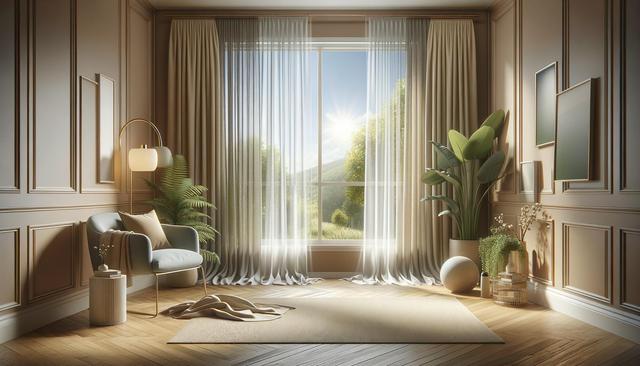Understanding the Differences Between Curtains and Blinds
Before you begin your search, it’s helpful to understand the fundamental differences between curtains and blinds. Curtains are fabric panels that hang from a rod and are typically used to add softness and style to a room. Blinds, on the other hand, are structured window coverings made from materials like wood, vinyl, or aluminum, and they operate with slats that tilt to control light and privacy.
When it comes to choosing between the two, consider the purpose of the room and your personal style. For instance:
- Curtains Living Room: Great for adding warmth and texture; ideal for spaces where you want a cozy, inviting atmosphere.
- Wood Window Blinds: Offer a natural, timeless look and are especially suited for spaces where durability and easy maintenance are priorities.
- Custom Window Blinds: A good option for oddly sized windows or for achieving a tailored look that matches your interior design.
Understanding these distinctions can help narrow down your options and guide you toward the most appropriate window treatments for each room in your home.
Choosing the Right Fabric and Material
The fabric or material you choose for your curtains or blinds plays a significant role in both appearance and functionality. For curtains, lighter fabrics like linen or cotton work well in airy spaces, while heavier fabrics such as velvet or tweed are better for insulation and blackout purposes. For blinds, options range from practical synthetic materials to elegant wood finishes.
Here are a few considerations based on material:
- Blackout Curtains: Excellent for bedrooms or media rooms where light control is essential.
- Wood Window Blinds: Provide a sophisticated aesthetic and are well-suited for studies or dining rooms.
- Window Shades And Blinds: Often made with fabric or woven materials, these offer a softer look compared to traditional blinds and work well in casual spaces.
Think about the room’s exposure to sunlight, moisture, and usage when selecting materials, as each of these factors can affect the longevity and performance of your window coverings.
Functional Considerations for Different Rooms
Each room in your home has unique requirements when it comes to window treatments. The goal is to balance style with functionality so that your curtains or blinds not only look great but also serve a practical purpose.
- Living Room: Consider layering Curtains Living Room style with sheer panels and heavier drapes to allow for both light control and privacy.
- Kitchen: Custom Window Blinds or light-filtering shades are ideal, offering easy cleaning and moisture resistance.
- Bedroom: Blackout Curtains or layered window shades provide optimal light control and insulation for restful sleep.
- Bathroom: Water-resistant Window Shades And Blinds offer privacy while withstanding humidity.
By tailoring your window treatments to each room’s needs, you’ll enhance both the functionality and cohesive design of your home.
Style and Aesthetic Integration
Window treatments are an important design element, and they should harmonize with the rest of your home decor. Whether your style is modern, traditional, rustic, or eclectic, there are curtains and blinds that can complement your vision.
Here’s how you can integrate window treatments into your overall aesthetic:
- Neutral Tones: Work well in minimalist or contemporary spaces and allow flexibility for future decor changes.
- Patterned Curtains: Add visual interest and can serve as a focal point in more traditional or eclectic rooms.
- Natural Finishes: Wood Window Blinds bring warmth and authenticity, perfect for rustic or Scandinavian-inspired interiors.
Don’t forget the hardware. Curtain rods, blind pull cords, and valances can add a decorative touch, so choose finishes and styles that match your existing furniture and fixtures.
Customization and Installation Tips
One of the most effective ways to achieve a polished look is through customization. Custom Window Blinds and tailored curtains ensure a perfect fit for your windows, especially if they are oversized or uniquely shaped. Customization also allows for a broader range of colors, patterns, and materials, aligning your window treatments with your personal taste and home design.
When it comes to installation, proper measurements are crucial. Here are a few tips:
- Measure the width and height of your windows precisely, and double-check before ordering.
- For Curtains Living Room setups, hang rods several inches above the window frame to create the illusion of height.
- Ensure brackets and mounting hardware are secured into wall studs or use appropriate anchors for stability.
If you’re unsure about handling the installation yourself, consider hiring a professional. This can help avoid common pitfalls like crooked mounting or improper fit, ensuring your Window Shades And Blinds function smoothly and look great.
Conclusion: Making the Right Choice for Your Home
Choosing the right curtains and blinds involves more than just picking a color or pattern—it requires considering the room’s purpose, desired functionality, and overall aesthetic. Whether you’re opting for the timeless appeal of Wood Window Blinds, the tailored fit of Custom Window Blinds, or the light-blocking benefits of Blackout Curtains, the right choice can elevate your space both visually and practically.
With thoughtful planning and attention to detail, your window treatments can become a defining element of your home decor. Use this guide as a reference point to navigate the many options available and to select window coverings that truly enhance your living environment.




Leave a Reply